So we were watching Food Network’s “Beat Bobby Flay” recently, and when the visiting chef issued the challenge for his signature dish, duck a l’orange, my husband, Les, looked at me and laid down a challenge of his own.
“You should make that for Christmas dinner.”
There was no typical playful talk, such as “you probably wouldn’t try to make that, would you?” Nope, this time, it was a matter-of-fact statement that activated every fear and insecurity about my kitchen skills, though it’s tough to explain why. I’ve cooked duck before and it turned out great. As recently as Valentine’s Day 2020, just as the COVID crisis began percolating across the world, I served seared duck breast with a cherry-Pinot Noir sauce that turned out so delicious. What was the big deal about duck breast this time? I cannot explain it.
Les knew that I had a package of duck breast in the freezer, and I do love a challenge, so I took the bait. I researched the origins of duck a l’orange and examined interpretations by numerous chefs I respect, and though I felt relatively confident headed into preparation on Christmas Day, I still had trouble with it for one simple reason—poor planning. I’ll spare you the dramatic, embarrassing highlights (there was some panicked yelling involved; pretend you’re hearing a censor’s beep right now) in favor of one important piece of advice: get your ducks in a row (pun intended) before you start cooking the duck breast. Rendering the fat off the duck is essential for crispy skin with tender, perfectly medium-rare meat. And it moves fast.
This recipe is not complicated, and the ingredients are simple. But once you begin cooking the duck, it demands your full attention. Have the side dishes, the sauce, the wine, music, table settings—all of it—ready in advance and this dish will work out fine. It was fancy in a classic kind of way, delicious and totally worth the trouble!

Recipe adapted from this one by Martha Stewart
Ingredients
2 pieces boneless duck breast, patted dry
Kosher salt and freshly ground black pepper
1/4 cup cane sugar
2 Tbsp. orange muscat champagne vinegar* (see notes)
2 oranges, juiced, plus the zest of one of the oranges*
1 medium shallot, minced*
3/4 cup low-sodium chicken broth
1 Tbsp. salted butter, cold from the fridge
*Notes
The orange muscat champagne vinegar is a Trader Joe’s product, but you may substitute any other variety of citrus-infused vinegar or a regular cider or white vinegar. The main thing is acidity, so substitute what you have on hand, but don’t use anything overly sweet.
Because the zest is used in the recipe, I highly recommend using organically-grown oranges. I used the juice of one regular navel orange, plus the juice and zest of one organic blood orange. Martha’s recipe calls for orange segments also, but I omitted them.
Shallot is recommended for this recipe, but if you do not have them, substitute finely minced sweet or red onion. Do not confuse shallots with scallions, which are green onions. The shape and flavor of the two are distinctly different.
Instructions
The recipe that inspired me listed only four steps in total, but what’s “easy” for Martha Stewart deserves a second look by the rest of us! I’ve broken it down into more specific tasks, to help you be fully prepared for the fast pace of the recipe. First, prep the duck and make the sauce.
- Using a very sharp knife, score the fatty side of the duck breast, making diagonal cuts about 1/2” apart over the entire surface of fat. Be careful not to cut into the flesh, as this will lead to overcooking the meat. Season both sides of the breast pieces with salt and pepper and set them aside while you make the sauce.
- In a glass measuring cup, combine vinegar, shallot, orange juice, orange zest and chicken broth.
- In a medium, heavy-bottomed sauce pot, cook sugar over medium heat until it becomes a dark amber color. Use a silicone spatula or scraper to move sugar to the middle of the pan as it begins to melt. Do not stir the melting sugar.
- When sugar is fully melted and deep amber in color, carefully pour in juice-broth mixture. This will sputter and pop quite a bit. Whisk mixture until it’s evenly blended, and reduce heat to low, simmering about 20 minutes until sauce is reduced to 2/3 cup volume. Give it a quick twist of black pepper, then set the pan aside for quick re-warming later.
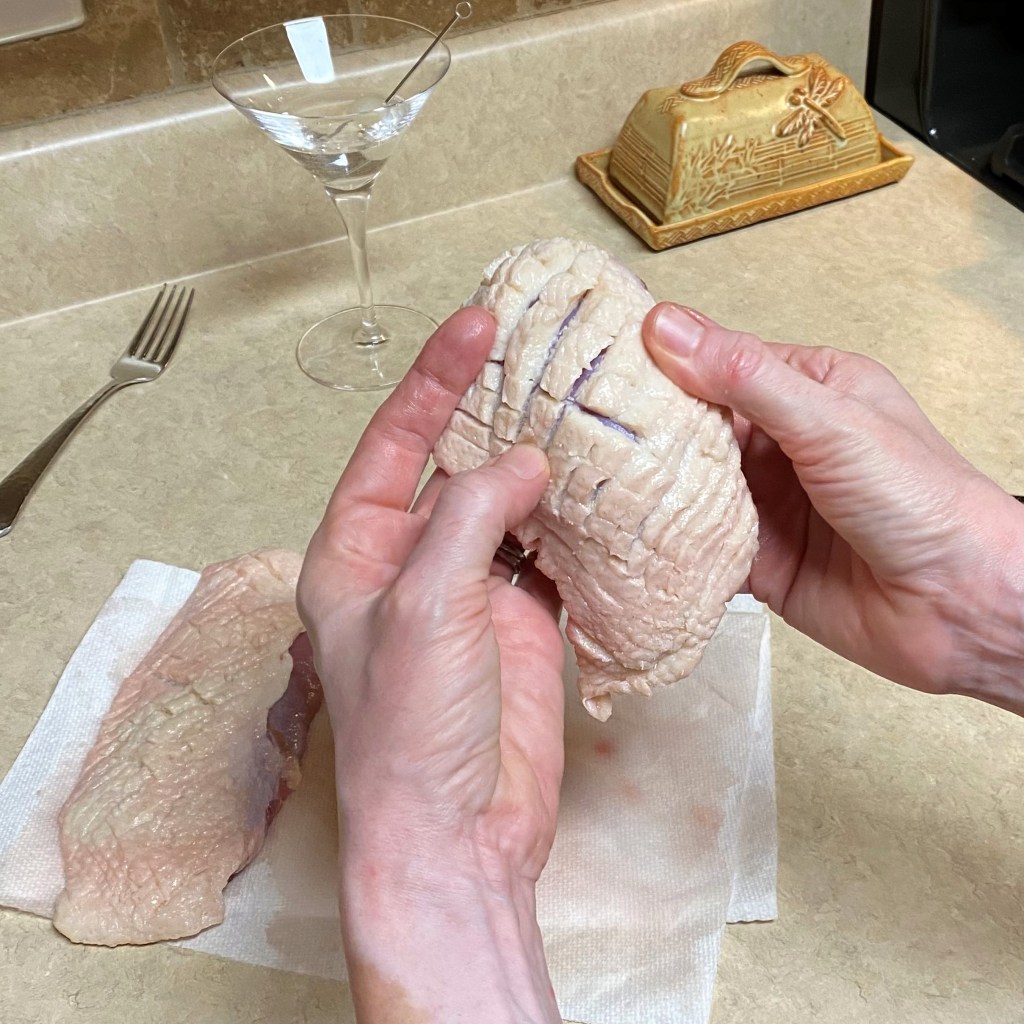
Scoring the duck fat ensures more even rendering. Be careful not to slice into the meat. 
Resist the urge to stir the sugar. 
Once it begins to melt, the caramelization will progress more quickly. 
Gently push the melted sugar to the center to prevent the edges burning. 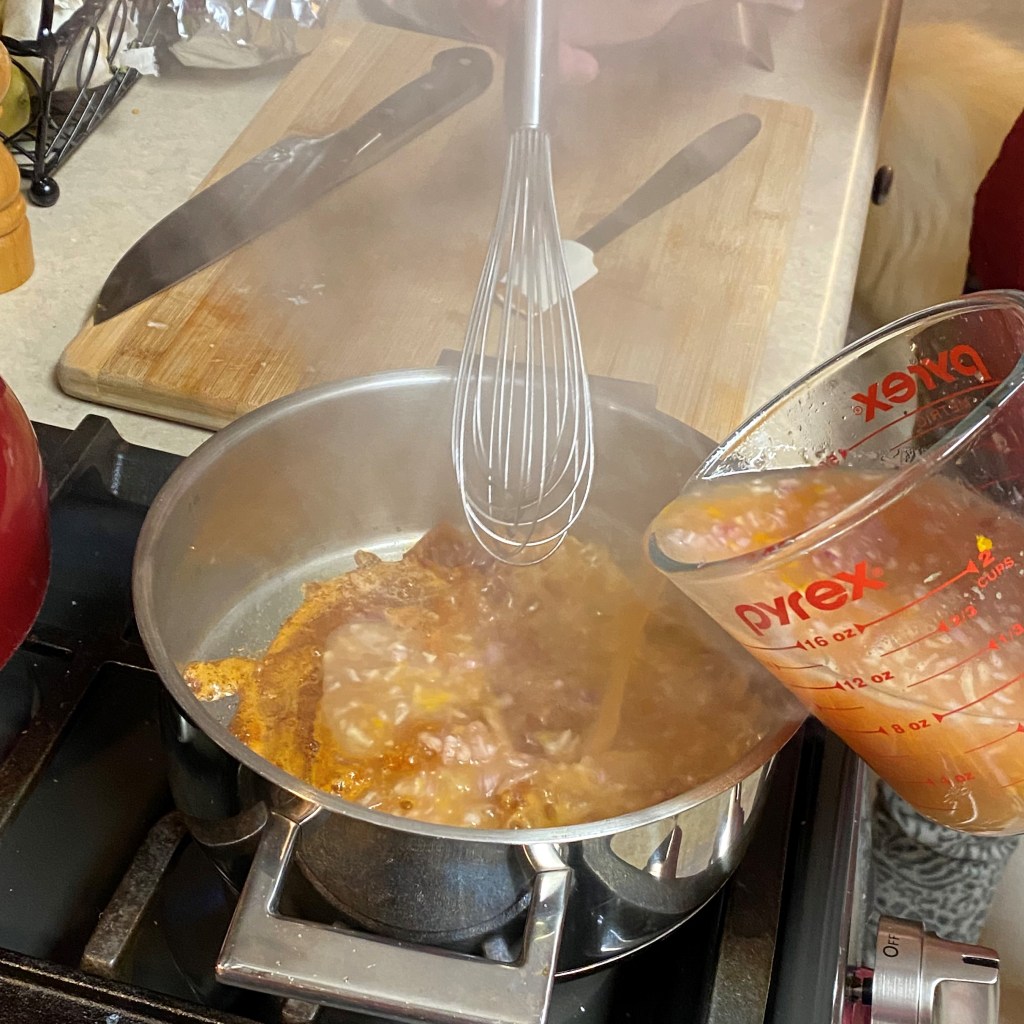
It helps to add the liquid quickly, but you should still expect sputtering and plenty of hot steam! 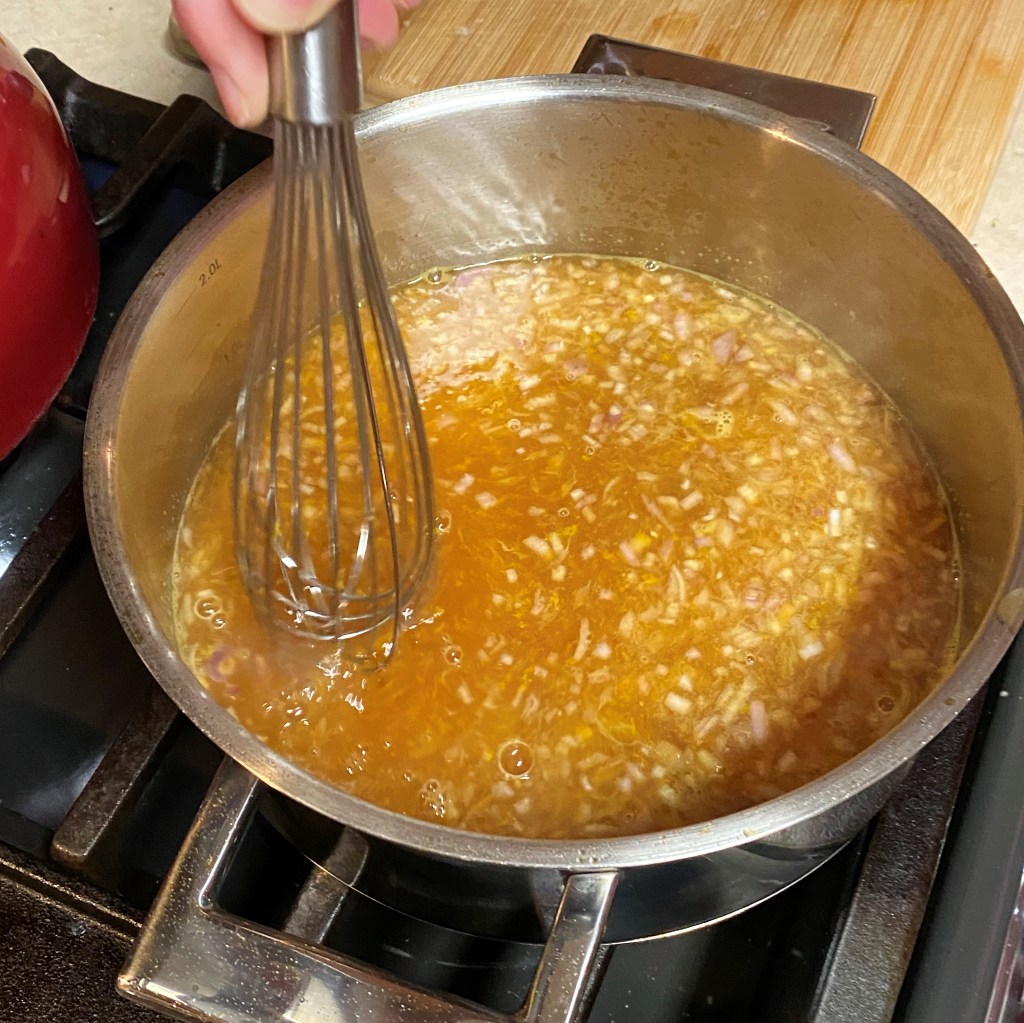
Give it a whisk to melt in the caramelized sugar, then simmer until it is reduced to about 2/3 cup volume.
Cooking the duck breast
- Heat a cast-iron skillet over medium-high heat. When skillet is warm (not hot), add duck breast, fat side-down and leave it alone for at least five minutes. This allows time for some of the fat to render from the duck breast. Use tongs to hold the duck breasts in place, while tilting the skillet to drain the duck fat off into another skillet or bowl and continue searing until the duck skin is crispy and golden brown, about 10 minutes total. (I used the drained-off duck fat to fry the smashed fingerling potatoes we served with dinner, but I recommend that you have a kitchen assistant to do that. Les handled the potato frying task, in addition to his expert photography of the cooking process.)
- When the fat is mostly rendered and duck skin is super crispy, turn the breast pieces over to cook the meat side for about 5 minutes. Internal temperature of the duck breast should be about 130° F for medium rare. Allow breast pieces to rest 8 to 10 minutes on a cutting board.
- While the duck breasts rest, place saucepan over medium heat to warm the orange sauce again. When mixture begins to steam and simmer at the edges, remove from heat and immediately add cold butter, swirling it with a fork to blend it into the sauce.
- Slice duck breasts into 1/2″ pieces. Fan slices of duck onto serving plates, spoon sauce over the slices and serve.

Place the breasts skin side-down into the skillet as soon as it begins to warm. 
Hold the duck breasts firmly with tongs while you tilt the skillet to drain off the rendered fat. 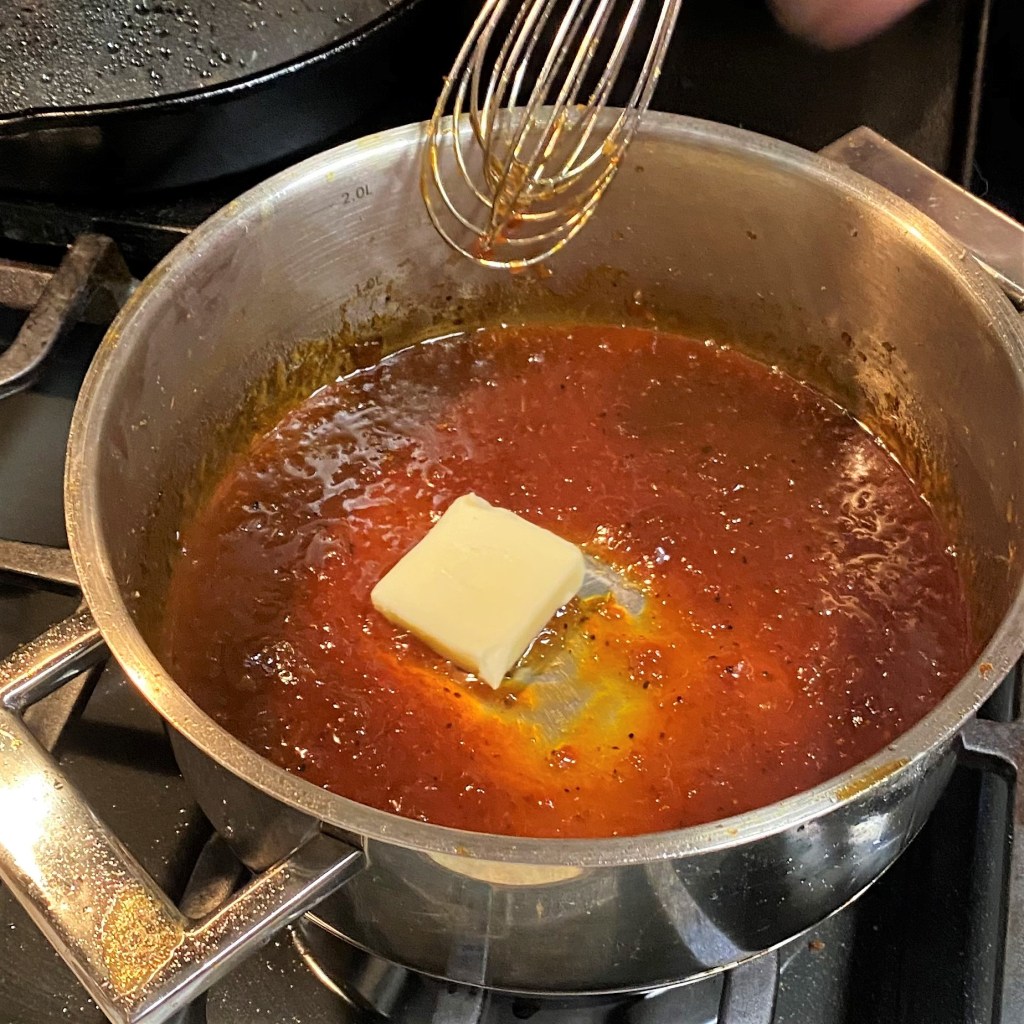
Swirl the cold butter into the sauce just before plating the duck. 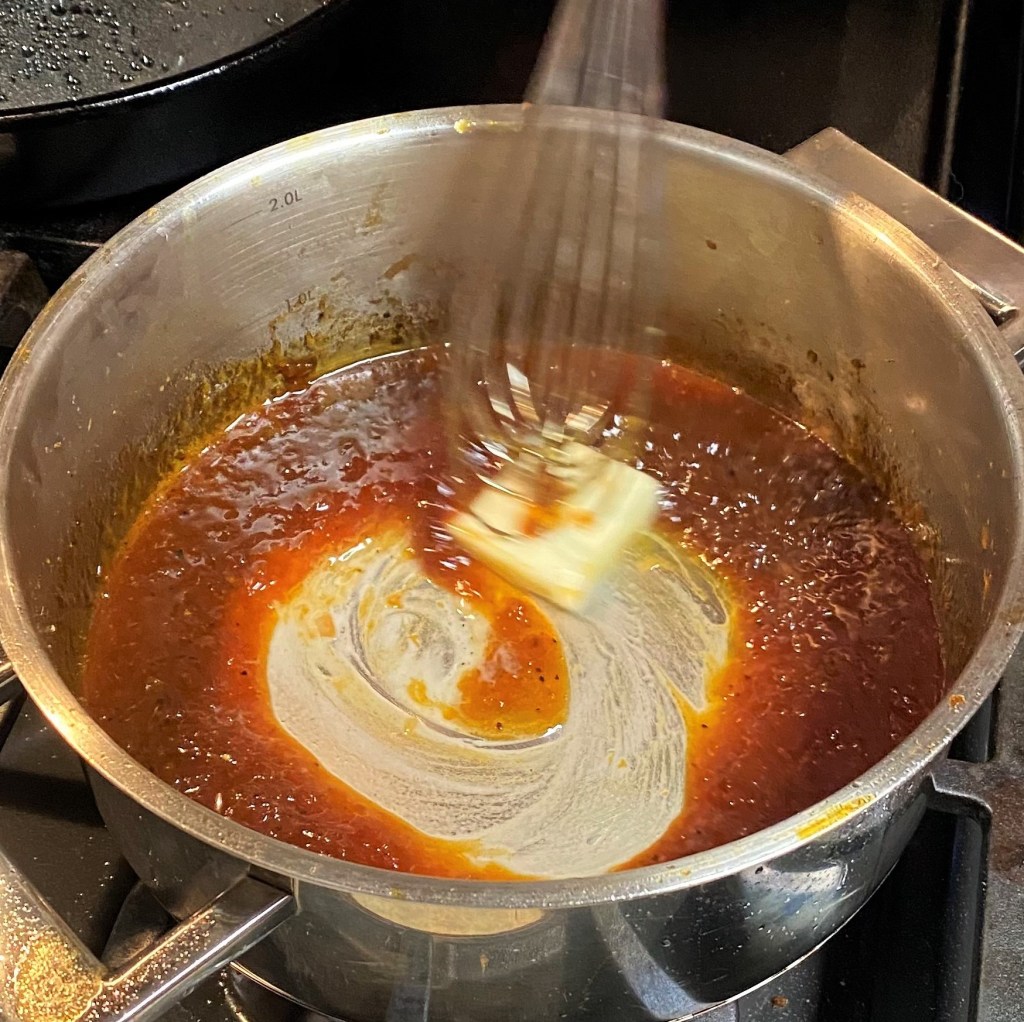
This is a classic French sauce technique. 
The butter lends a silkiness to the sticky sauce. 
Up close, you can see the succulent layer of duck fat, nestled perfectly between the juicy meat and the crispy skin. 
We served the duck a l’orange with pan-fried fingerling potatoes. Boil the potatoes until fork-tender, then cool slightly and gently smash, or flatten, them with the bottom of a skillet or pan. Set them aside until you’re ready to crisp them for serving. Heat extra duck fat or butter over medium-high heat. Fry smashed potatoes in fat until golden brown and crispy. Sprinkle with salt and pepper and serve.
Your eyes do not deceive—the wine we served with the duck a l’orange also has an orange hue. I’ve been curious about these orange-colored wines for at least a year, but did not find one until I visited the website for Grovedale Winery in northeastern Pennsylvania. The wine, called Serendipity, is made from Frontenac Gris grapes. Contrary to its appearance, it does not taste like oranges, though the winery suggests there are notes of candied orange peel on the finish. I found it similar in style and flavor to a dry Riesling, and I cannot describe how perfectly it paired with the duck a l’orange. Grovedale also uses this interesting grape for a late harvest dessert wine, which I purchased and cannot wait to experience. We will be ordering more of this, for sure!
Want to make this recipe?
One more thing…
You may be wondering if I’m a paid endorser for the products I spotlight on Comfort du Jour, and the answer is “no.” I do not receive money or products for my recommendations, and what that means for you is that you can trust me to give an honest opinion. If something changes, I will update my disclosures. Either way, I will only stand behind services and products I believe in. Fair enough? 😀
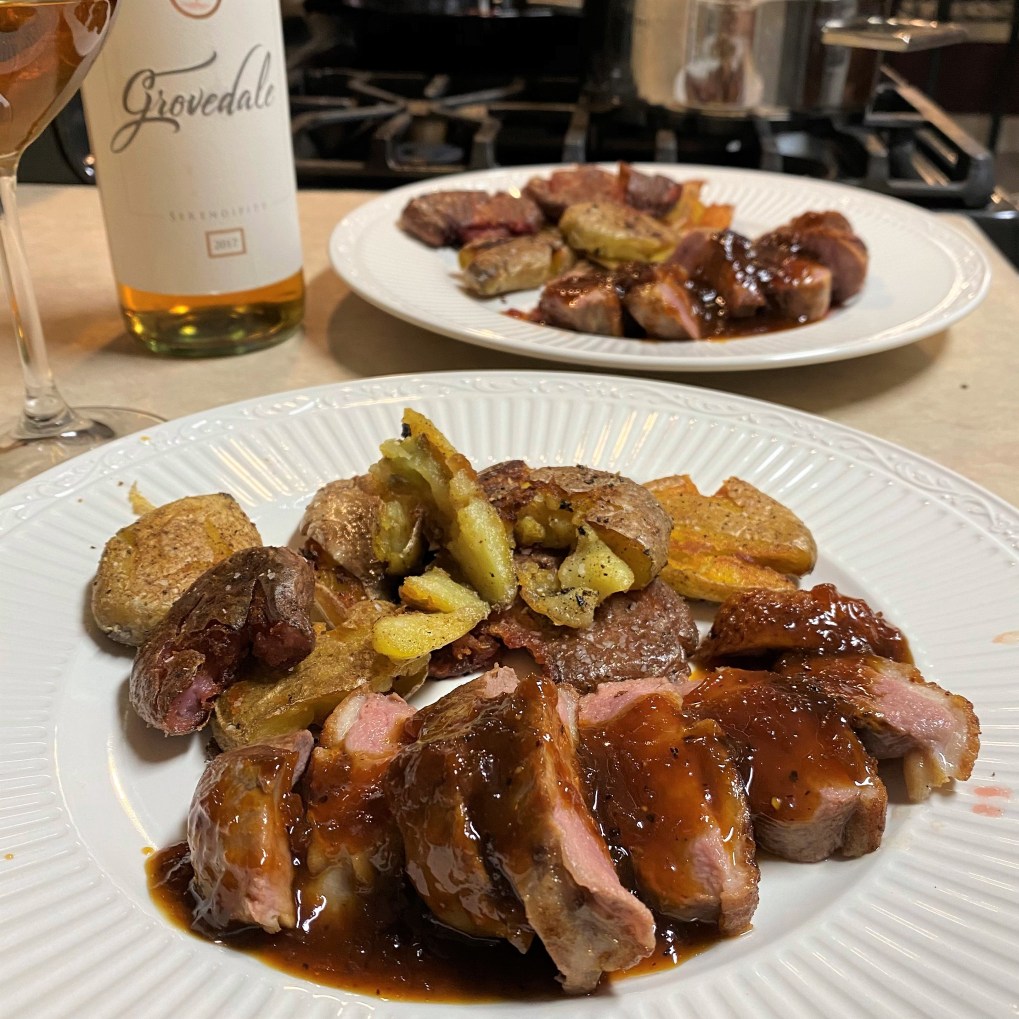
4 thoughts on “Duck a l’Orange”